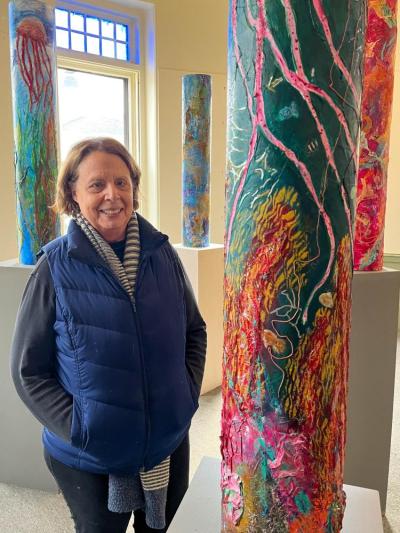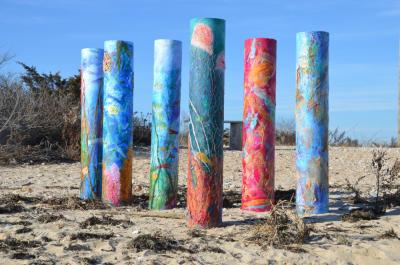Dartmouth Cultural Center students reflect on the ocean for online exhibit
An upcoming online exhibit from the National Association of Women Artists spotlights art teachers, art schools and their students — so it seemed a natural fit for Gallery Director Jill Law to spotlight the Dartmouth Cultural Center and three of its longtime students: Beth Russo, Bob Vesprini and Iria Devalles-Vieira.
NAWA’s call for art provided no guidelines to the artists, which meant coming up with an idea took significant work on its own. All three students could have submitted separate unconnected work if they wanted to, but Law thought part of the experience should be working on the project “as a unit.”
“They wanted to do something with the ocean, the water, because we’re basically in the water — every day, it’s more and more,” Law said.
The artwork series, called “Neptune’s Rabbit Hole” contains six circular tubes that each artist painted, sanded, decoupaged or covered with items. Each artist created a pair of tubes, but all six are inspired by the ocean. Starting Feb. 1, the tubes will be on display in the online exhibition “Imaginary Playground,” hosted by the National Association of Women Artists.
“I think it’s going to be small to begin, but grow once people see it,” Law said.
The idea for the circular form for the works stemmed from an exhibit at the Grimshaw-Gudewicz gallery at Bristol Community College, in which painted tubes hung from the ceiling. The work depicted on the tubes was more abstract and concerned a different subject matter, but the exhibit helped the DCC students choose the medium itself.
The three students each interpreted the oceanic focus on their own terms. Russo, in particular, chose to represent the sea entirely in abstract images, while the other two students dove more explicitly into representing underwater life.
The “canvas,” so to speak, are individual sonotubes, a common construction material that is typically used as a mold for creating concrete supports in the ground. Similar to a paper towel roll, sonotubes have large ridges winding down the outside, so the artists had to work hard to disguise the coiled lines.
Some of the items that the artists pasted onto the tubes came straight from the ocean, including some of the bits of rope and net on Vesprini’s works. Vesprini said his tube is meant to illustrate an underwater environment, including all of the sea creatures that may be there.
Artist Beth Russo said her intention was to convey “movement in the water,” and said the cheesecloth she placed onto her cylinders aids in that goal.
The cultural center is not open throughout the winter, but the public may view the work by appointment while it remains in the gallery.
When the Cultural Center reopens in March, its first exhibit will highlight the work of AP art students at Dartmouth High School.


















